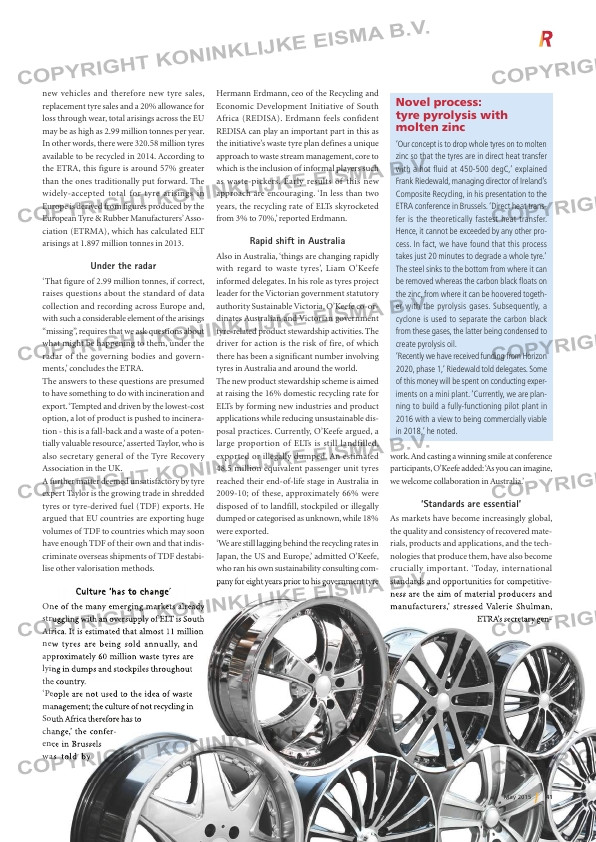Page 41 from: May 2015

new vehicles and therefore new tyre sales,
replacement tyre sales and a 20% allowance for
loss through wear, total arisings across the EU
may be as high as 2.99 million tonnes per year.
In other words, there were 320.58 million tyres
available to be recycled in 2014. According to
the ETRA, this figure is around 57% greater
than the ones traditionally put forward. The
widely-accepted total for tyre arisings in
Europe is derived from figures produced by the
European Tyre & Rubber Manufacturers’ Asso-
ciation (ETRMA), which has calculated ELT
arisings at 1.897 million tonnes in 2013.
Under the radar
‘That figure of 2.99 million tonnes, if correct,
raises questions about the standard of data
collection and recording across Europe and,
with such a considerable element of the arisings
“missing”, requires that we ask questions about
what might be happening to them, under the
radar of the governing bodies and govern-
ments,’ concludes the ETRA.
The answers to these questions are presumed
to have something to do with incineration and
export. ‘Tempted and driven by the lowest-cost
option, a lot of product is pushed to incinera-
tion – this is a fall-back and a waste of a poten-
tially valuable resource,’ asserted Taylor, who is
also secretary general of the Tyre Recovery
Association in the UK.
A further matter deemed unsatisfactory by tyre
expert Taylor is the growing trade in shredded
tyres or tyre-derived fuel (TDF) exports. He
argued that EU countries are exporting huge
volumes of TDF to countries which may soon
have enough TDF of their own and that indis-
criminate overseas shipments of TDF destabi-
lise other valorisation methods.
Culture ‘has to change’
One of the many emerging markets already
struggling with an oversupply of ELT is South
Africa. It is estimated that almost 11 million
new tyres are being sold annually, and
approximately 60 million waste tyres are
lying in dumps and stockpiles throughout
the country.
‘People are not used to the idea of waste
management; the culture of not recycling in
South Africa therefore has to
change,’ the confer-
ence in Brussels
was told by
Hermann Erdmann, ceo of the Recycling and
Economic Development Initiative of South
Africa (REDISA). Erdmann feels confident
REDISA can play an important part in this as
the initiative’s waste tyre plan defines a unique
approach to waste stream management, core to
which is the inclusion of informal players such
as waste-pickers. Early results of this new
approach are encouraging. ‘In less than two
years, the recycling rate of ELTs skyrocketed
from 3% to 70%,’ reported Erdmann.
Rapid shift in Australia
Also in Australia, ‘things are changing rapidly
with regard to waste tyres’, Liam O’Keefe
informed delegates. In his role as tyres project
leader for the Victorian government statutory
authority Sustainable Victoria, O’Keefe co-or-
dinates Australian and Victorian government
tyre-related product stewardship activities. The
driver for action is the risk of fire, of which
there has been a significant number involving
tyres in Australia and around the world.
The new product stewardship scheme is aimed
at raising the 16% domestic recycling rate for
ELTs by forming new industries and product
applications while reducing unsustainable dis-
posal practices. Currently, O’Keefe argued, a
large proportion of ELTs is still landfilled,
exported or illegally dumped. An estimated
48.5 million equivalent passenger unit tyres
reached their end-of-life stage in Australia in
2009-10; of these, approximately 66% were
disposed of to landfill, stockpiled or illegally
dumped or categorised as unknown, while 18%
were exported.
‘We are still lagging behind the recycling rates in
Japan, the US and Europe,’ admitted O’Keefe,
who ran his own sustainability consulting com-
pany for eight years prior to his government tyre
work. And casting a winning smile at conference
participants, O’Keefe added: ‘As you can imagine,
we welcome collaboration in Australia.’
‘Standards are essential’
As markets have become increasingly global,
the quality and consistency of recovered mate-
rials, products and applications, and the tech-
nologies that produce them, have also become
crucially important. ‘Today, international
standards and opportunities for competitive-
ness are the aim of material producers and
manufacturers,’ stressed Valerie Shulman,
ETRA’s secretary gen-
Novel process:
tyre pyrolysis with
molten zinc
‘Our concept is to drop whole tyres on to molten
zinc so that the tyres are in direct heat transfer
with a hot fl uid at 450-500 degC,’ explained
Frank Riedewald, managing director of Ireland’s
Composite Recycling, in his presentation to the
ETRA conference in Brussels. ‘Direct heat trans-
fer is the theoretically fastest heat transfer.
Hence, it cannot be exceeded by any other pro-
cess. In fact, we have found that this process
takes just 20 minutes to degrade a whole tyre.’
The steel sinks to the bottom from where it can
be removed whereas the carbon black fl oats on
the zinc, from where it can be hoovered togeth-
er with the pyrolysis gases. Subsequently, a
cyclone is used to separate the carbon black
from these gases, the latter being condensed to
create pyrolysis oil.
‘Recently we have received funding from Horizon
2020, phase 1,’ Riedewald told delegates. Some
of this money will be spent on conducting exper-
iments on a mini plant. ‘Currently, we are plan-
ning to build a fully-functioning pilot plant in
2016 with a view to being commercially viable
in 2018,’ he noted.
41May 2015
RI 4-Tyre recycling.indd 41 30-04-15 14:41



